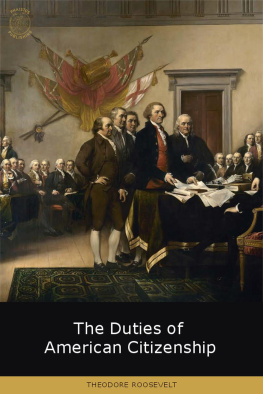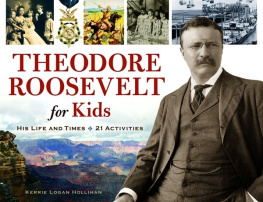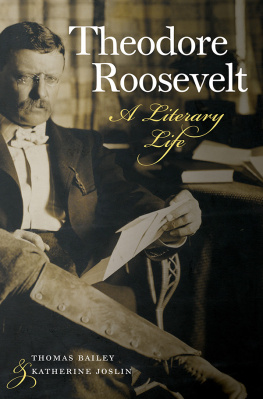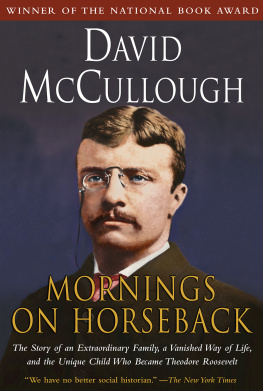A MOST GLORIOUS RIDE
T HE D IARIES OF T HEODORE R OOSEVELT ,
18771886
EDITED BY
Edward P. Kohn
AN IMPRINT OF STATE UNIVERSITY OF NEW YORK PRESS
Cover: Photograph of Theodore Roosevelt in his first year in the New York State Assembly, 1882. Courtesy of the Theodore Roosevelt Collection, Houghton Library, Harvard University (call number 520.13-003).
Published by
S TATE U NIVERSITY OF N EW Y ORK P RESS , A LBANY
2015 State University of New York
All rights reserved
Printed in the United States of America
No part of this book may be used or reproduced in any manner whatsoever without written permission. No part of this book may be stored in a retrieval system or transmitted in any form or by any means including electronic, electrostatic, magnetic tape, mechanical, photocopying, recording, or otherwise without the prior permission in writing of the publisher.
Excelsior Editions is an imprint of State University of New York Press
For information, contact
State University of New York Press, Albany, NY
www.sunypress.edu
Production and book design, Laurie Searl
Marketing, Anne M. Valentine
Library of Congress Cataloging-in-Publication Data
Roosevelt, Theodore, 18581919.
[Diaries. Selections.]
A most glorious ride : the diaries of Theodore Roosevelt, 18771886 / edited by Edward P. Kohn.
pages cm (Excelsior editions)
Includes bibliographical references and index.
ISBN 978-1-4384-5513-6 (hardcover : alk. paper)
ISBN 978-1-4384-5515-0 (e-book)
1. Roosevelt, Theodore, 18581919Diaries. 2. PresidentsUnited StatesDiaries. 3. PresidentsUnited StatesBiography. I. Kohn, Edward P. (Edward Parliament), 1968 editor. II. Title.
E757.A3 2015
| 973.911092dc23 |
| [B] | 2014013125 |
10 9 8 7 6 5 4 3 2 1
Contents
Preface
Theodore Roosevelt as Diarist
Theodore Roosevelt was a compulsive list-maker and journal-writer. The Theodore Roosevelt Collection at Harvard University is full of notebooks with titles such as Notes on Natural History, Zoological Record, and Remarks on the Zoology of Oyster Bay. In addition to diaries Roosevelt kept during two tours of Europe as a boy and young adolescent, he also kept a diary as lieutenant colonel of the Rough Riders during the Cuban campaign of 1898.
The diaries from 1877 to 1886 cover a key time in Roosevelts life and reveal how Roosevelt changed from a homesick and frequently ill adolescent at Harvard, to a strapping and confident young man. The diaries recount Roosevelts many love interests before he finally won the hand of Alice Hathaway Lee. As well as love, the diaries recount loss. Heartbreaking entries cover the death of Roosevelts father, mother, and wife. In addition to Roosevelts personal life, the diaries offer a glimpse of Roosevelts start in New York politics and of his three terms in the New York State Assembly. Finally, the diaries also describe his first trips out West and a large part of his two-year Western sojourn before returning to New York in 1886 after he became secretly engaged to Edith Carow, his childhood friend and adolescent love interest.
Biographers of Roosevelt have necessarily relied on the diaries to gain insight into Roosevelt. In the 1950s Carleton Putnam drew heavily on the diaries when they were still in the possession of Roosevelts eldest daughter, Alice, and the resulting biography, Theodore Roosevelt: The Formative Years , is probably the best treatment of Roosevelts early life until 1886. In his Pulitzer Prize-winning The Rise of Theodore Roosevelt , Edmund Morris calls the diaries the most revealing documents to survive. David McCullough also relies heavily on the diaries for the relevant chapters in his National Book Award-winning Mornings on Horseback . The diaries obviously helped bring to life Theodore Roosevelt in a way that pleased readers and critics alike. Since these volumes, most biographers have tended to quickly slide past the years covered by the diaries. As a result, the diaries have arguably been underused in exploring Roosevelts early life, or, as Putnam correctly called them, his formative years.
Such lack of utilization of a valuable biographical source may result from the fact that until now the diaries have never been published. The question is: Why? The failure to publish the diaries may result from several factors. First, unlike many of the thousands of letters published in Elting Morisons The Letters of Theodore Roosevelt , all diary entries are handwritten rather than typed. Deciphering Roosevelts writing, spelling, penmanship, and use of colloquial and specialized language is a daunting challenge. The second factor may be simple logistics. The diaries are not held in a single place. The first and last volumes are part of the Theodore Roosevelt Collection, Houghton Library, Harvard College, and the other volumes are part of the Library of Congresss Theodore Roosevelt Collection. Finally, Roosevelt was not a consistent diarist. The 1877 volume contains about fifty entries, while the volumes covering 18781881 contain more comprehensive entries. The diaries from 1882 to 1886 are once again sparser, with no diary at all for 1885. Moreover, Roosevelt had a tendency to rip out entries. This was particularly the case in his 1884 diary after the death of his first wife, Alice, in February of that year. After her death Roosevelt also destroyed many of her letters and photographs. As a result there exists a great lack of personal information about Roosevelt for the years 18841886a lacuna, as Morris notes.
This volume presents the diaries published in their entirety for the first time. Annotations seek to explain the people, places, and events Roosevelt noted. Entries are presented as Roosevelt penned them, complete with misspellings and grammatical mistakes. The notation sic has been used sparingly, usually when the mistake is particularly egregious or potentially confusing, while the correct spellings of names and places are given in footnotes. As Roosevelt used a fountain pen, inkblots have rendered some entries illegible. An introduction and conclusion summarize Roosevelts life before and after the years covered by the diaries in order that this volume might serve as a single source covering his entire life. At the center are Roosevelts personal diaries from 1877 to 1886, covering his life from age eighteen to twenty-seven. They provide a fascinating and intimate glimpse into the life and early political career of the young man who would one day become one of Americas most important presidents.
Introduction
Theodore Roosevelts Life until 1877
Theodore Roosevelt was born in New York City on October 27, 1858, in a luxurious brownstone house near Gramercy Park. His father, Theodore Roosevelt Sr., was a partner in Roosevelt and Son with the Roosevelt family patriarch, the future presidents grandfather Cornelius Van Schaack Roosevelt. Theodore Roosevelt Sr. was a great philanthropist in his day, helping found the Newsboys Lodging House and Orthopedic Dispensary Hospital, as well as the American Museum of Natural History and the Metropolitan Museum of Art. During the Civil War, Roosevelt Sr. had paid a substitute rather than risk being conscripted into the army, a common practice among men of his class. Instead, he became one of three allotment commissioners, responsible for persuading soldiers to set aside part of their monthly pay for their families back home.







